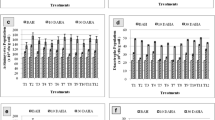Abstract
The aqueous extracts of decomposing rice residues in soil exhibited inhibition on the radicle growth of lettuce and rice seeds and the growth of rice seedlings. The phytotoxicity was found in extracts obtained from the early stage of decomposition (first month), and gradually declined thereafter. The inhibition was also found in extracts obtained from rice fields, and was persistent for 4 months. The root initiation of hypocotyl cuttings of mungbeans was suppressed by extracts of decaying rice residues and extracts obtained from paddy soil. Five phytotoxins,p-hydroxybenzoic,p-coumaric, vanillic, ferulic, ando-hydroxyphenylacetic acids, and several unknowns were found in the decomposing rice residues under waterlogged conditions. At 25 ppm,o-hydroxyphenylacetic acid revealed significant inhibition on the radicle growth of rice and lettuce seeds and suppressed root initiation of mungbean seedlings. It was concluded that the growth of rice seedlings was retarded by decaying rice residues in soil; thus, this appeared to be an autointoxication phenomenon.
Similar content being viewed by others
References
Blum, U., andRice, E.L. 1969. Inhibition of symbiotic nitrogen-fixation by gallic and tannic acid, and possible roles in old-field succession.Bull. Torrey Bot. Club 96:531–544.
Börner, H. 1960. Liberation of organic substances from higher plants and their role in the soil sickness problem.Bot. Rev. 26:393–424.
Börner, H. 1971. German research on allelopathy, pp. 52–56,in Biochemical Interactions Among Plants. National Academy of Sciences, Washington, D.C.
Chandrasekaran, S., andYoshida, T. 1973. Effect of organic acid transformations in submerged soils on the rice plants.Soil Sci. Plant Nutr. Tokyo 19:39–45.
Chou, C.-H., andChung, Y.-T. 1974. The allelopathic potential ofMiscanthus floridulus.Bot. Bull. Acad. Sin. 15:14–27.
Chou, C.-H., andYoung, C.-C. 1975. Phytotoxic substances in twelve subtropical grasses.J. Chem. Ecol. 1:183–193.
Hais, I.M., andMacek, K. 1963. Paper Chromatography. Publishing House of the Czechoslovak Academy of Sciences, Prague. 955 pp.
International Rice Research Institute. Annual Report 1965. pp. 58–63.
International Rice Research Institute. Annual Report 1971. pp. 30–33.
International Rice Research Institute. Annual Report 1972. pp. 44–45.
International Rice Research Institute. Annual Report 1973. pp. 111–116.
Kuwatsuka, S., andShindo, H. 1973. Behavior of phenolic substances in the decaying process of plants. I. Identification and quantitative determination of phenolic acids in rice straw and its decayed product by gas chromatograph.Soil Sci. Plant Nutr. Tokyo 19:219–227.
McCalla, T.M. 1971. Studies on phytotoxic substances from micro-organisms and crop residues at Lincoln, Nebraska, pp. 39–43,in Biochemical Interactions Among Plants. National Academy of Sciences, Washington, D.C.
McPherson, J.K., Chou, C.-H., andMuller, C.H. 1971. Allelopathic constituents of the chaparral shrubAdenostoma fasciculatum.Phytochemistry 10:2925–2933.
Muller, C.H. 1966. The role of chemical inhibition (allelopathy) in vegetational composition.Bull. Torrey Bot. Club 93:332–351.
Muller, C.H. 1974. Allelopathy in the environmental complex, pp. 73–85,in B.R. Strain and W.D. Billings (eds.), Vegetation and Environment. Dr. W. Junk B.V. Publishers, The Hague.
Patrick, Z.A. 1965. Crop residues in soil can be toxic.Research for Farmers Can. Dept. Agr. 10(3):4–6.
Patrick, Z.A., andKoch, L.W. 1958. Inhibition of respiration, germination, and growth by substances arising during the decomposition of certain plant residues in the soil.Can. J. Bot. 36:631–647.
Rice, E.L. 1965. Inhibition of nitrogen-fixing and nitrifying bacteria by seed plants. II. Characterization and identification of inhibitors.Physiol. Plant. 18:255–268.
Rice, E.L. 1974. Allelopathy. Academic Press, New York. 353 pp.
Rice, E.L., andPancholy, S.K. 1972. Inhibition of nitrification by climax ecosystems.Am. J. Bot. 59:1033–1040.
Rice, E.L., andPancholy, S.K. 1973. Inhibition of nitrification by climax ecosystems. II. Additional evidence and possible role of tannins.Am. J. Bot. 60:691–702.
Rice, E.L., andPancholy, S.K. 1974. Inhibition of nitrification by climax ecosystems. III. Inhibitors other than tannins.Am. J. Bot. 61:1095–1103.
Stevenson, F.J. 1967. Organic acids in soil, pp. 119–142,in A.D. McLaren and G.H. Peterson (eds.), Soil Biochemistry. Marcel Dekker, Inc., New York.
Takijima, Y. 1960.Nippon Dojo-Hiryogaku Zasshi 31:435.
Toussoun, T.A., Weinhold, A.R., Linderman, R.G., andPatrick, Z.A. 1968. Nature of phytotoxic substances produced during plant residue decomposition in soil.Phytopathology 58:41–45.
Vázquez, A., Méndez, J., Gesto, M.D.V., Seoane, E., andVieitez, E. 1968. Growth substances isolated from woody cutting ofSalix viminalis andFicus carica L.Phytochemistry 7:161–167.
Wang, T.S.-C., Cheng, S.-Y., andTung, H. 1967a. Dynamics of soil organic acids.Soil Sci. 104:138–144.
Wang, T.S.-C., Yang, T.-K., andChuang, T.-T. 1967b. Soil phenolic acids as plant growth inhibitors.Soil Sci. 103:239–246.
Wang, T.S.-C., Yeh, S.-L., Cheng, S.-Y., andYang, T.-K. 1971. Behavior of soil phenolic acids, pp. 113–120,in Biochemical Interactions Among Plants. National Academy of Sciences, Washington, D.C.
Author information
Authors and Affiliations
Additional information
Paper No. 176 of the Scientific Journal Series, Institute of Botany, Academia Sinica. This study was financially supported by the National Science Council, the Republic of China.
Rights and permissions
About this article
Cite this article
Chou, CH., Lin, HJ. Autointoxication mechanism ofOryza sativa I. Phytotoxic effects of decomposing rice residues in soil. J Chem Ecol 2, 353–367 (1976). https://doi.org/10.1007/BF00988282
Received:
Revised:
Issue Date:
DOI: https://doi.org/10.1007/BF00988282




